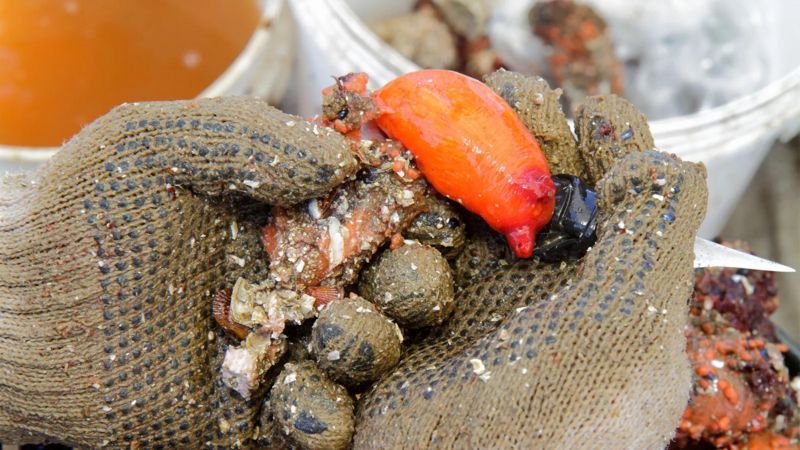“Piure” has become a staple in some of Chile’s top food establishments, thanks to a global gastronomy industry that continues to encourage the use of local, sustainable ingredients.
The first time you see piure (also known as pyura chilensis ), you might think this is not an appetizing seafood dish.
Although served along the coast of Chile, its strong iodine taste, combined with its “ugly” appearance, makes piure less appealing to consumers.
The mild flavors of clams, scallops and loco tend to be preferred. Loco is a Chilean sea snail usually eaten with mayonnaise.
However, as more chefs creatively incorporate it into dishes, piure could become the next hero of Chilean cuisine.
Found on the coasts of Peru and Chile, the piure is a tunicate (also known as a sea-squirt ) – a spineless marine animal that feeds by sucking water through one tube and expelling it through another – that looks like something extraordinary.
Looking like solid rock, each boulder consists of dozens of piures gathered together, its surface ‘studded’ with something that resembles warts and strands of hair (algae).
In the noisy fishing port of Valparaiso, on Chile’s central coast, piure is sold either in the form of natural “stones”, or “udders” (like mammary glands) that have been cleaned and ready to eat.
A customer asked for a piure in the shape of a stone and indicated his choice. When the seller lifts it onto the scales, the animal expels seawater from a small hole protruding from the surface.
Although there are various types of pyura in the world, only the pyura chilensis species is edible, said Dr Pilar Haye, Deputy Director of the Millennium Institute for Coastal Socio-Ecology (Secos).
Haye helpfully explains that the enchanting rock-like shape of the piure camouflage is the basis of which can consist of anywhere from one to thousands of individuals living in a matrix community.
“The red, soft body is the edible part, surrounded by what looks like rock,” Haye said.
“It’s an exoskeletal structure that piure produces for them to live in.”
Chef Rodrigo Sepúlveda Vargas often visits the port of Valparaiso to look for ingredients for his restaurant, Quintaycocina.
He said he had been eating piure from a young age and was immediately fascinated.
“It’s like diving into the sea with your mouth wide open, because it feels like the ocean,” he said while wearing an apron in his restaurant kitchen.
“ Piure is not a traditional Chilean dish; it’s mostly people from fishing areas who eat it,” says Sepúlveda Vargas, who appreciates piure’s healthful properties.
“ Piure contains iron, iodine – high in vitamins. My mission is to get people used to eating it.”
At her restaurant, Sepúlveda Vargas washes the pungent stone, before taking a knife to cut through its incredibly soft, porous surface.
He then took out its bright red flesh, then took out about a dozen small creatures from one stone.
Chile has a coastline of 6,435 kilometers and preparations for processing piure differ from one bay to another.
In the cooler southern parts of Chile, piure is hung on strings to dry, then added to soups and stews.
In the arid northern regions, piure is eaten fresh and raw with a sauce of lemon juice.
For those trying piure for the first time, Sepúlveda Vargas recommends eating empanadas .
In Quintaycocina, he combines a little chopped piure with onions, cilantro and cheese. The mixture is stored in a light batter container, which is then fried.
While piure has long been enjoyed by coastal communities, a number of chefs in the capital Santiago, 96 kilometers inland, are now working to make piure available to city dwellers.
Thanks to a global gastronomic push to use locally sourced and sustainable ingredients, piure has become a staple ingredient in some of Chile’s best restaurants, in the capital’s posh and upscale districts.
At the country’s most exclusive restaurant, Boragó, chef Rodolfo Guzmán channels piure’s signature flavors into dishes like ceviche with clams.
To best understand the taste and texture of piure , Guzmán broke it down and experimented with various cooking techniques.
He found that the skin of the piure had a “very citrusy…very citrusy” taste, while the inside was “intense, full of iodine”.
He found that separating sea-squirts and using the skin and insides in a variety of recipes was the key to showcasing its unique, diverse and flavorful essence.
For example, the skin is perfect for a light, floral spring ceviche , while the guts are best suited to the thicker garum (fish sauce).
“Boragó is about Chilean regional momentum,” says Guzmán, explaining that the establishment was born out of a mission to use endemic Chilean ingredients in a way that had never been done before.
Piure is one of Guzman’s favorites. “It opens up a whole new spectrum of possibilities for us for cooking.”
On the winter menu, Guzmán serves a sea pesto that combines strong guts with seaweed extract over mariscal , a hot seafood soup.
“It’s very gentle. It’s not like biting all the way through; we enjoy the beauty and the wonderful taste of the sea,” he said. ” Piure has it all.”
While it may sound unpleasant, Guzmán explains that when it comes to processing piure , how much to use is key.
You want to make an impression, but not overdo it. “Proportions in cooking are as relevant as the quality of the ingredients,” he said.
“The work of haute cuisine involves the transformation of simple ingredients into something more complex,” says Ana Rivero Pérez, food journalist and communications director of Ñam Chile, the country’s most important annual food festival.
Rivero Pérez “loved” Guzmán’s experiments with piure , but also appreciated Santiago seafood restaurants such as La Calma, Squella, and El Ancla for serving piure in simpler, more traditional ways, such as in soup or chopped raw in salads.
“They bring people closer to the piure , which is found in its natural state, straight from the sea.”
Rivero Pérez calls piure a “beautiful” seafood and hopes more Chileans will dare to discover its taste.
“Even though Chile has a coastline of almost 6,500 kilometers, Chileans have a low consumption of fish and seafood,” he said.
” Piure is just one example of what we should have more of in our diet.”
Back at Quintay Cocina, Sepúlveda Vargas prepared a piure salad mixed with onions, cilantro, lettuce and plenty of lemon juice squeezed on top to balance the strong flavor of the sea-squirt.
Separately, he puts the pisco — a fermented Chilean grape spirit — into a mixer with the remaining pieces of piure , then strains the concoction into a glass so diners can shake off any remaining flavors.
Sepúlveda Vargas spooned her piure salad on a slice of toast and took a bite.
“This is pure sea,” he said, his eyes widening after feeling the potency of this sea-squirt . “I love it.”
You can read the English version of this article, Chile’s ‘ugly’, edible sea-squirt on BBC Travel
Source : BBC
















